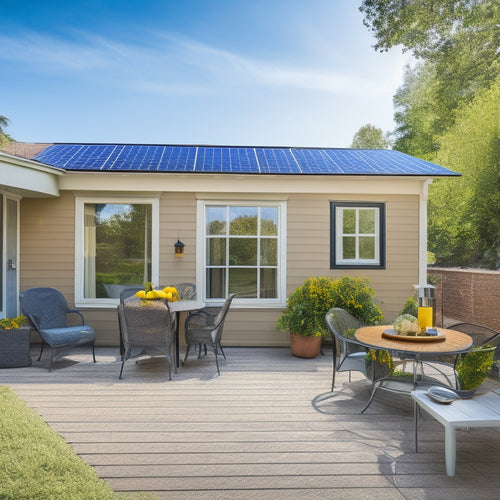
3 Essential Steps for New Building Energy Savings
Share
You can greatly reduce your building's energy consumption and costs by focusing on three critical areas. First, conduct an energy efficiency analysis to understand your energy usage, gathering data on past utility bills, energy audits, and building specifications. Next, identify areas where your building is wasting energy, using specialized tools to uncover hidden inefficiencies in insulation, windows, HVAC systems, and lighting. Finally, implement energy-saving strategies like green technologies, occupancy sensors, and building management systems to optimize energy efficiency. By following these essential steps, you'll be well on your way to slashing energy waste and costs - and there's even more to explore.
Key Takeaways
• Conduct an energy efficiency analysis to identify areas of potential improvement in building's energy usage and gather data on past utility bills and building specifications.
• Pinpoint areas of energy waste by conducting a thorough audit to uncover hidden inefficiencies in insulation, windows, HVAC systems, and lighting systems.
• Implement energy-saving strategies such as installing LED lights, occupancy sensors, and integrating building management systems to monitor and control energy consumption.
• Optimize HVAC systems through zoning and scheduling to reduce heating and cooling energy waste and improve overall building efficiency.
• Implement green technologies and smart building solutions to reduce energy consumption and achieve significant energy savings in new buildings.
Conducting Energy Efficiency Analysis
To initiate the energy-saving process, you must conduct an energy efficiency analysis to identify areas of potential improvement in your building's energy usage. This important step involves a thorough examination of your building's energy consumption patterns and systems.
You'll need to gather data on your building's energy usage, including past utility bills, energy audits, and building specifications. This data will help you understand your building's energy profile and pinpoint areas where energy is being wasted.
Building inspections are an essential part of this process, as they provide valuable insights into your building's energy systems and identify opportunities for improvement. Energy modeling is another key tool, allowing you to simulate different energy-saving scenarios and predict the impact of various energy-efficient upgrades.
Identifying Energy Wasting Areas
By pinpointing areas where your building is hemorrhaging energy, you can focus your efforts on the most important upgrades and maximize your energy savings. Identifying energy-wasting areas is vital to optimizing your building's energy efficiency. To do this, you'll need to conduct a thorough audit using specialized audit tools. These tools will help you uncover hidden inefficiencies that might be escaping your attention.
During the audit, pay attention to areas such as insulation, windows, and HVAC systems. These are common culprits when it comes to energy waste. Look for signs of air leaks, moisture issues, and inadequate insulation.
You should also investigate your building's lighting systems, as outdated or inefficient lighting can be a significant energy drain. By identifying these energy-wasting areas, you'll be able to prioritize upgrades and retrofits that will have the greatest impact on your energy savings.
With a clear understanding of where your building is wasting energy, you'll be well-equipped to make data-driven decisions that drive real results.
Implementing Energy Saving Strategies
With a clear understanding of where your building is wasting energy, you're ready to implement energy-saving strategies that will drive real results. Now it's time to put your energy-saving plan into action.
Implementing green technologies and smart building solutions can greatly reduce your building's energy consumption. Consider installing energy-efficient lighting systems, such as LED lights, and occupancy sensors to optimize energy usage.
You can also integrate building management systems (BMS) to monitor and control energy consumption in real-time. Additionally, consider implementing HVAC optimization strategies, such as zoning and scheduling, to reduce heating and cooling energy waste.
Frequently Asked Questions
What Is the Average ROI for Energy-Efficient Building Upgrades?
When you invest in energy-efficient building upgrades, you can expect an average ROI of 15-20%, depending on the scope of the project, which can be boosted by financial incentives, and informed by a thorough energy audit that identifies areas of improvement.
How Do Energy Savings Impact Property Resale Value?
When you invest in energy-efficient upgrades, you'll likely see a boost in property resale value, as appraisal methods consider energy savings, and market trends show homebuyer preferences for eco-friendly features, making energy disclosure a key aspect of real estate marketing.
Can Energy-Efficient Buildings Command Higher Rental Rates?
You'll likely find that energy-efficient buildings can command higher rental rates, driven by market demand for sustainable spaces, which boosts tenant retention, enhances landlord reputation, and leads to longer rental duration and favorable lease terms.
What Are the Tax Incentives for Energy-Efficient Building Upgrades?
As you start on energy-efficient upgrades, you'll discover a treasure trove of tax incentives, including Energy Credits and Green Loans, which can greatly reduce your taxable income, putting more green in your pocket.
Do Energy-Efficient Buildings Have Higher Occupant Productivity Rates?
You'll find that energy-efficient buildings often boast improved air quality, optimized lighting design, and a focus on workplace wellness, all of which can boost employee morale, support mental health, and ultimately, increase occupant productivity rates.
Related Posts
-

10 Tips to Buy Affordable Solar Panels Online
When purchasing affordable solar panels online, you'll want to research reputable retailers, compare prices, and chec...
-

Top 10 Tips for Buying Car Accessories Online
When purchasing car accessories online, you should take proactive steps to avoid low-quality or incompatible products...
-

Why Cities Need Smart Charging Infrastructure Now
You're about to experience a tidal wave of electric vehicles hitting your city's streets, and it's essential you're p...


